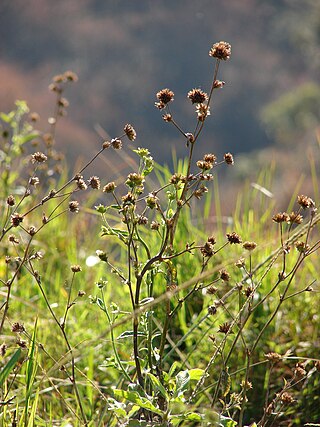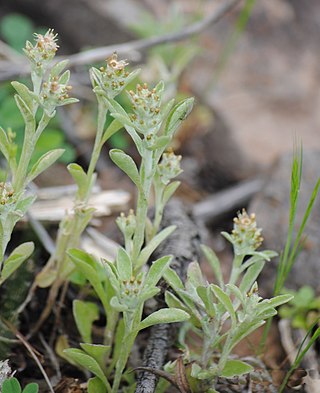
Rodolfo AmandoPhilippi was a German–Chilean paleontologist and zoologist. Philippi contributed primarily to malacology and paleontology. His grandson, Rodulfo Amando Philippi Bañados (1905-1969), was also a zoologist and in order to avoid confusion in zoological nomenclature, the elder is referred to as "Philippi [Krumwiede]" to distinguish him from his grandson "Philippi [Bañados]".

Bidens laevis is a species of flowering plant in the daisy family known by the common names larger bur-marigold and smooth beggarticks. It is native to South America, Mexico, and the southern and eastern United States. It grows in wetlands, including estuaries and riverbanks.

Podophorus is an extinct genus of plants in the grass family. The only known species is Podophorus bromoides, which was native to Robinson Crusoe Island in the South Pacific Ocean. This is one of the Juan Fernández Islands, part of the Republic of Chile. The plant was last collected in the wild in the mid-19th century and is now considered extinct. A genetic analysis of the type material found it to be most closely related to Megalachne, also endemic to the Juan Fernández archipelago. This clade was in turn found to be nested within a paraphyletic Festuca, most closely related to F. pampeana of South America.

Chersodoma is a genus of South American flowering plants in the daisy family. Members of this genus or dioecious shrubs or subshrubs.
Gypothamnium is a genus of South American flowering plants in the family Asteraceae.
Leunisia is a genus of Chilean flowering plants in the family Asteraceae.
Lycapsus is a genus of flowering plants in the tribe Perityleae within the family Asteraceae.

Oxyphyllum is a genus of South American flowering plants in the family Asteraceae.
Synedrellopsis is a genus of South American plants in the tribe Heliantheae within the family Asteraceae.

Gamochaeta is a genus of flowering plants in the family Asteraceae. There has not always been agreement among botanists regarding its status as a recognized genus, but it has become more accepted in recent years. It currently includes many plants that previously belonged in genus Gnaphalium. Like many species of Gnaphalium, many Gamochaeta are called cudweeds or everlastings.

Bidens triplinervia is a Latin American species of flowering plants in the sunflower family. It is native to Mesoamerica and South America, from Chihuahua State in northern Mexico to Jujuy Province in northern Argentina.

Solaria is a genus of South American plants in the family Amaryllidaceae, subfamily Allioideae, tribe Gilliesieae, native to Chile and Argentina.
Traubia is a genus of Chilean plants in the Amaryllis family. Only one species is recognized, Traubia modesta, native to northern and central Chile.
Oxychloe is a genus of plants in family Juncaceae described as a genus in 1860.
Cotula mexicana, also known as Mexican brassbuttons, is a plant species in the sunflower family. It is widespread in South America and also found in central Mexico and parts of the United States.

Elephantopus mollis, common names tobacco weed, and soft elephantsfoot, is a tropical species of flowering plant in the family Asteraceae.
Tagetes campanulata is a South American species of plants in the family Asteraceae. It is found in Argentina and Bolivia.
Tagetes pusilla, the lesser marigold, is a Latin American species of marigolds in the family Asteraceae. It is native Central America and western South America from Guatemala to northern Argentina.

Flaveria bidentis, the coastal plain yellowtops, is a South American plant species of Flaveria within the family Asteraceae. It is native to South America, and naturalized in many places.

Gamochaeta pensylvanica, the Pennsylvania cudweed or Pennsylvania everlasting, is a widespread species of flowering plant in the family Asteraceae. It is native to South America and introduced into Eurasia, Africa, Australia, and North America. The pensylvanica epithet is a misnomer, as the plant is not native to Pennsylvania and only marginally naturalized there.











